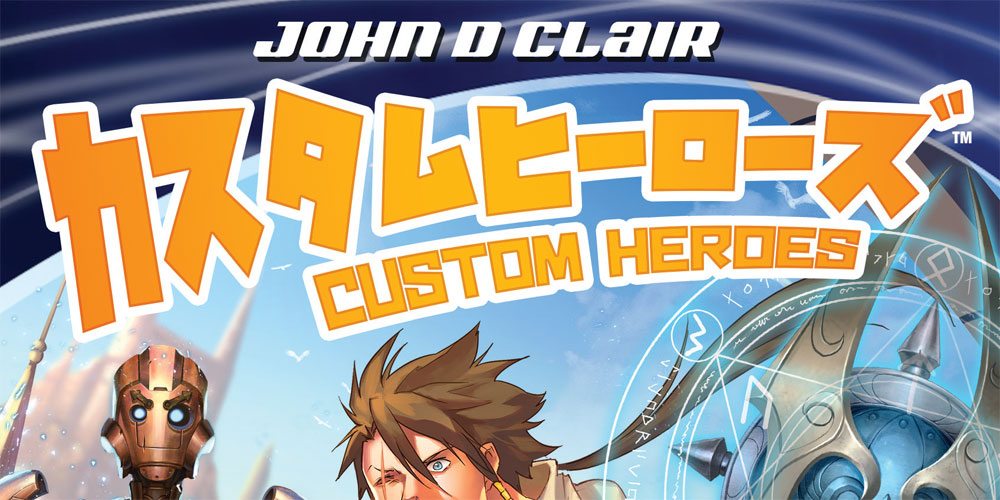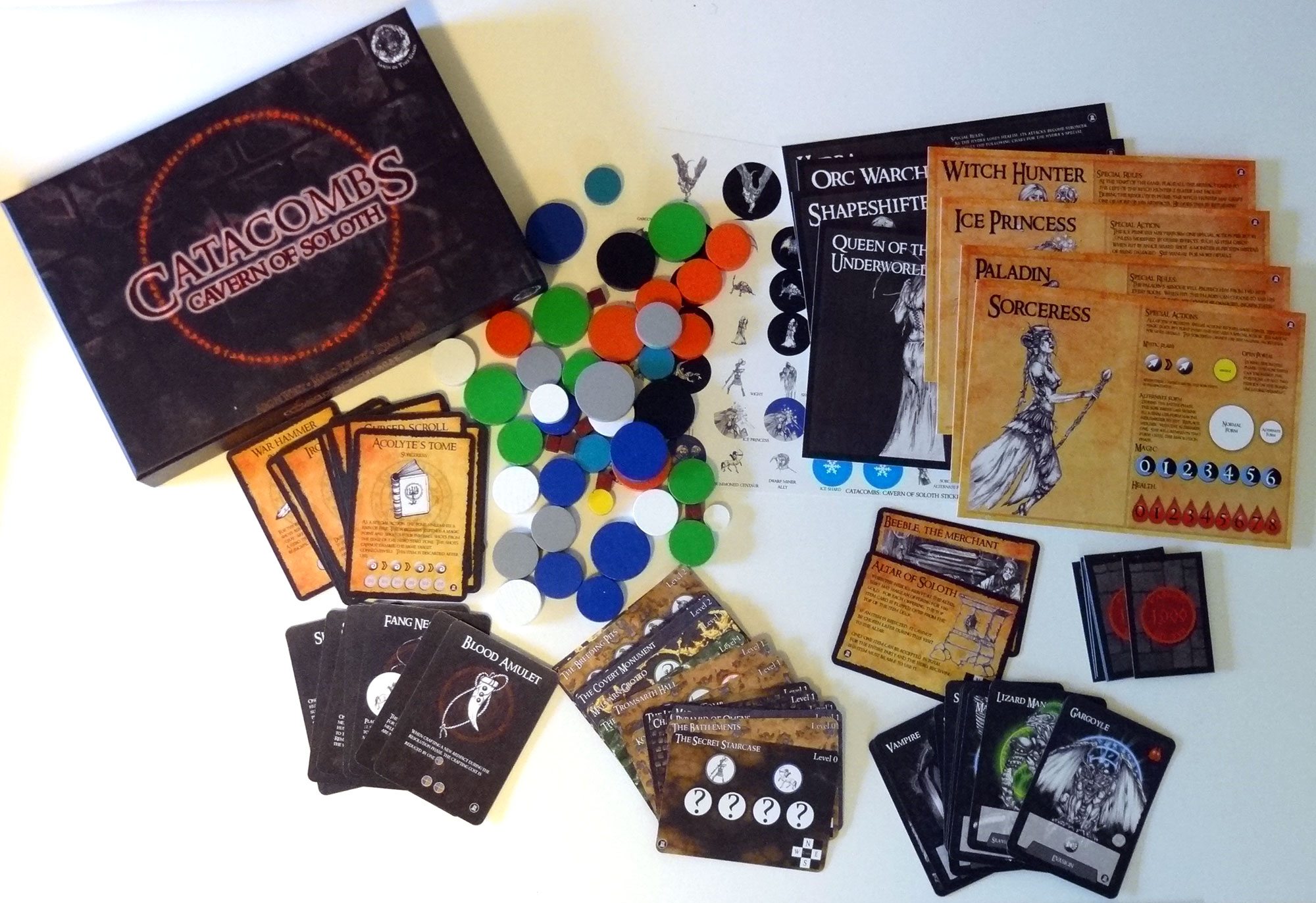Power up your heroes with card overlays to win tricks—but beware, because the hero you altered this round may end up in the hand of your opponent next round!
What Is Custom Heroes?
Custom Heroes is a ladder-style trick-taking game for 2 to 6 players, ages 14 and up, and takes about 45 minutes to play. It was released at Gen Con this year, and is now in stores and online, retailing for $29.99. The game can be taught to younger players; the illustrations feature some manga-style characters that show a bit of skin but nothing too risque.
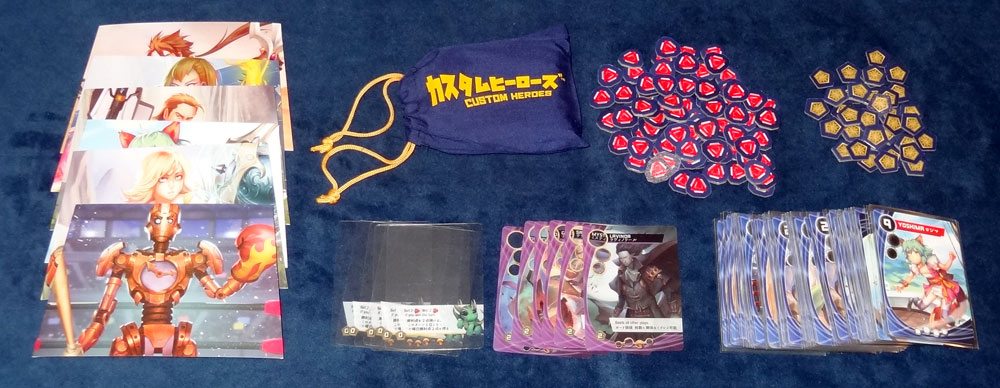
Custom Heroes Components
- 60 Character cards
- 84 Card Advancements
- 80 card sleeves
- 76 Victory Point tokens
- 36 Power tokens
- 6 player screens
- 1 Card Advancement bag
Custom Heroes is another title using AEG’s Card Crafting System (like Mystic Vale), which uses transparent cards that layer on top of each other to change the cards. The character cards are regular cards, but the card advancements are clear plastic cards with some modifications printed on them. The plastic card sleeves are provided for the character cards, and you slide advancements into the sleeves to modify them. The sleeves are big enough so that you can insert up to 4 advancements per card, and the extra sleeves are a nice touch in case you tear any.
The card advancement bag is a nice cloth bag that’s just big enough to hold the deck of advancements. Since the cards are clear and you can see through the cards, the entire deck is placed into the opaque bag and you draw advancements from the bag. The plastic cards have a transparent film on them (for the printing process) that can be peeled off—you don’t have to peel it all off before you play, but the cards are more clear and sharp without the film. My kids happened to enjoy peeling the film off so they ended up going through the whole deck. The film becomes easier to peel after the cards have been handled for a while.
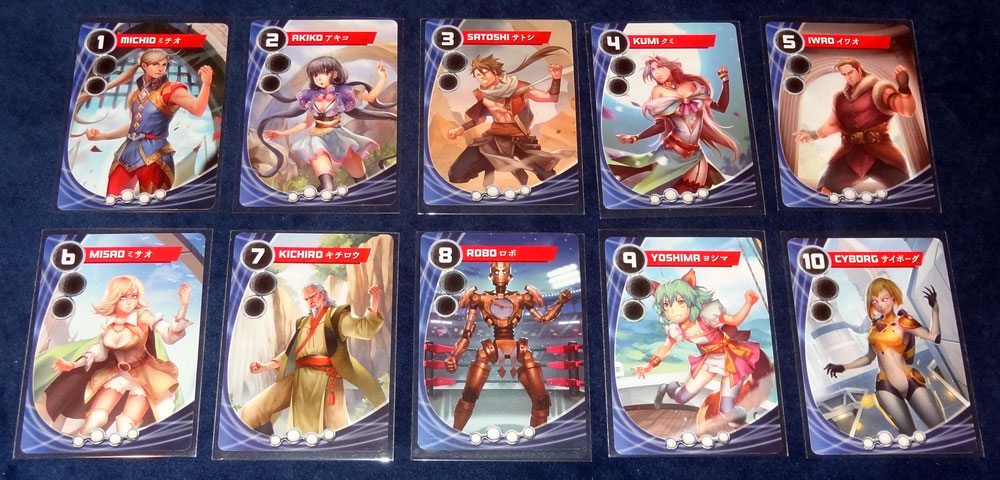
The artwork, done by Caravan Studio, is manga-inspired and features various characters, including a couple of robots. The characters all have a similar pose (left arm raised, right arm extended) so that the various overlay cards fit onto them, adding various items to their hands. Some fit better than others, but it’s fun to see the way the characters get modified as you play.
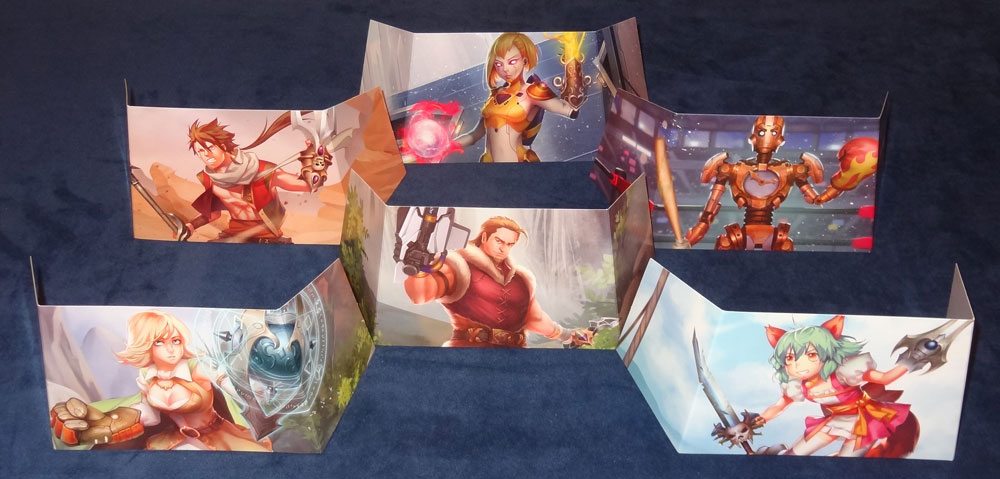
The player screens depict various characters, but with modifications on their hands, which is kind of fun. The back of the player screen has a player aid showing the rewards for finishing a round, depending on the number of players.
The various cardboard tokens are small punch-outs, red triangles for VPs and gold pentagons for power tokens.
The rulebook is in both English and Japanese; Custom Heroes is part of AEG’s “Big in Japan” line, which includes some games from Japanese designers and some US-made games that AEG has taken to Japan. In this case, the game is from American designer John D. Clair but made its debut in Japan at Game Market Tokyo 2017.
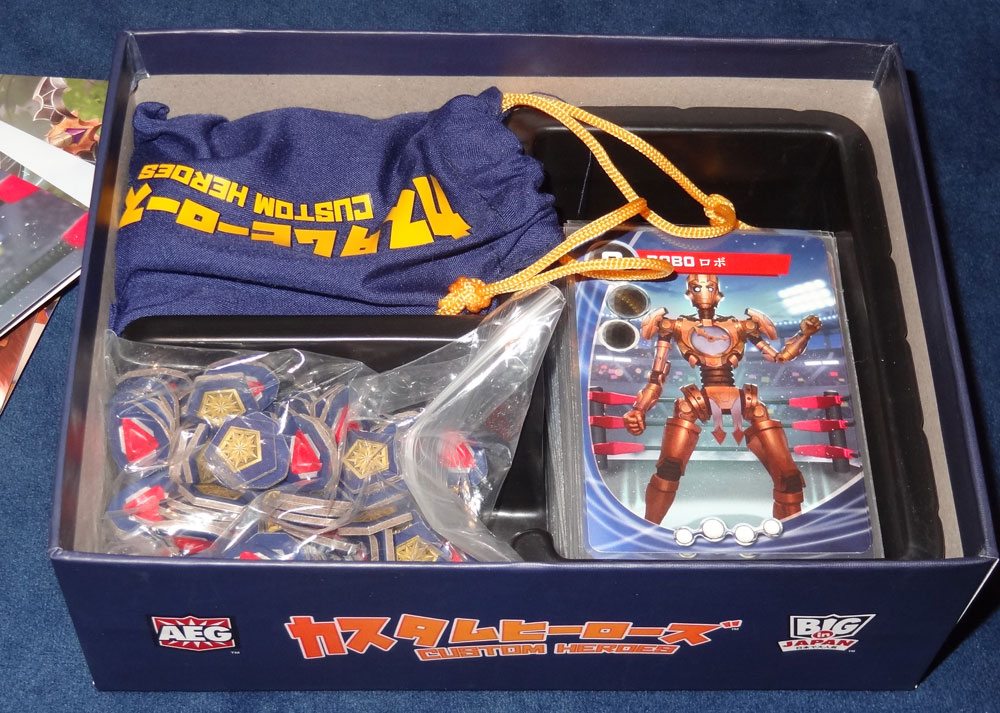
The box size is nice—enough room to hold all the sleeved cards in one side of the insert, and then two card trays that can hold the advancements and all the tokens. Player screens go on top. I stored the extra sleeves underneath all the character cards.
How to Play Custom Heroes
The Goal
The object of the game is to earn 10 VP and then win a round.
Setup
Use one set of basic character cards (values 1 to 10) per player, and shuffle them together into a single deck. (Any other character cards are returned to the box.) Each player starts with 1 Ascended Form advancement, 1 Kodora advancement, and 1 random advancement from the bag. Each player also takes 1 VP token, 2 power tokens, and a player screen. (In a 2-player game, you use 3 full sets of basic cards, and each player starts with 2 random advancements instead of 1.)

Gameplay
The round has three phases: Upkeep Phase, Main Phase, and Scoring Phase.
Upkeep: deal the deck out evenly to all players. Players may now declare if they wish to use their Kodora effect, which lets you gamble 2 VP that you will place first this round. If you do, you gain 2 more VP; otherwise, the VP you gambled is lost. The Kodora advancement is placed into a card, and the card is placed in front of your screen, no longer in your hand for the round.
Main: Choose a starting player for the first round; in subsequent rounds, the last place player becomes the first player in the next round.
The starting player may play a set of cards to start the trick: it may be either a single card or any number of cards with the same value. Subsequent players must match that number of cards, with either the same or a higher value. The cards you play on each turn must have the same value as each other. For instance, if the first player started with 3 cards of value 7, then you must follow with 3 cards of equal value to each other, either 7 or higher.
If you play the same value as the previous player, then you skip the turn of the next player. (Except in a 2-player game, in which you must play cards of a higher value and there is no skipping.)
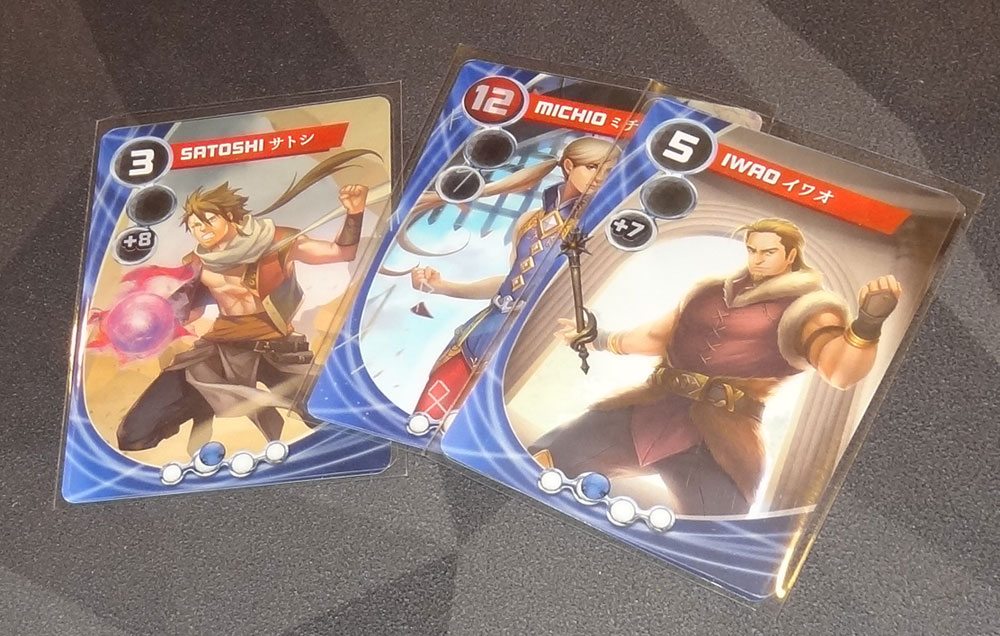
You may also pass if you cannot or do not want to play; you may still play later this trick if you get another opportunity.
If everyone passes (or is skipped) and it gets back to the last player who played cards, then that player wins the trick. The pile of cards is discarded, and the winner gets to start the next trick. (If the winner is out of cards, the next player to the left gets to start.)
At any time, you may add advancements to the cards in your hand by sliding them into the sleeve. Each advancement has one of four possible colored dots at the bottom, which match the four dots across the bottom of the character cards. Each character may only have up to one of each of the colored dots.
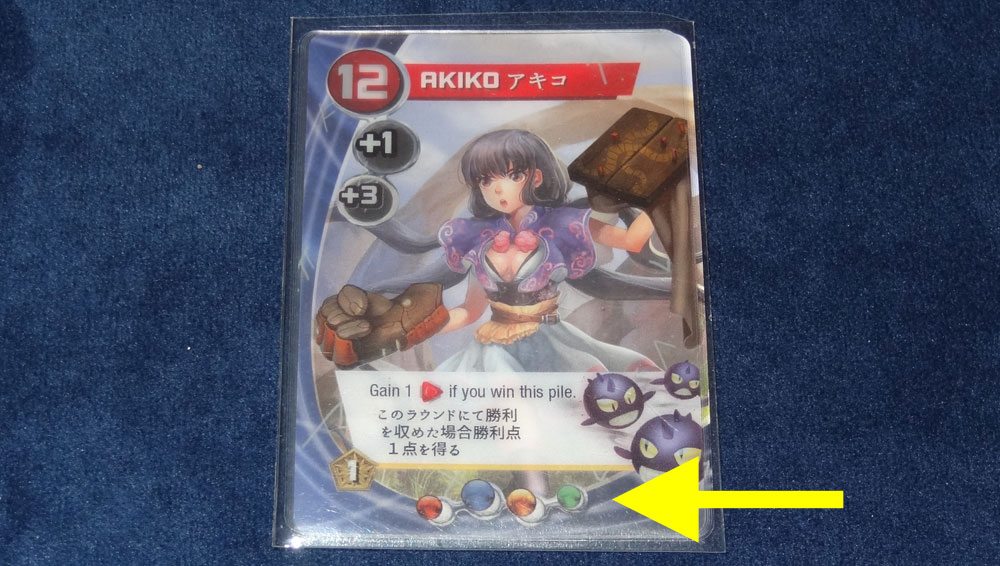
Advancements may alter the value of the card, or they may have a special ability. Most special ability cards have a power cost—you must pay the cost to the bank in order to use the ability, but you may play a card with an advancement without using its ability if you don’t wish to pay for it.
The Ascended Form is a special advancement—each player starts with one. It’s a trump card, and if you pay 2 power, the Ascended Form beats everything. You play it on its own, and it can only be followed by another Ascended Form (which then ties it, skipping the next player).
Once advancements are added to a card, they are not removed for the rest of the game.
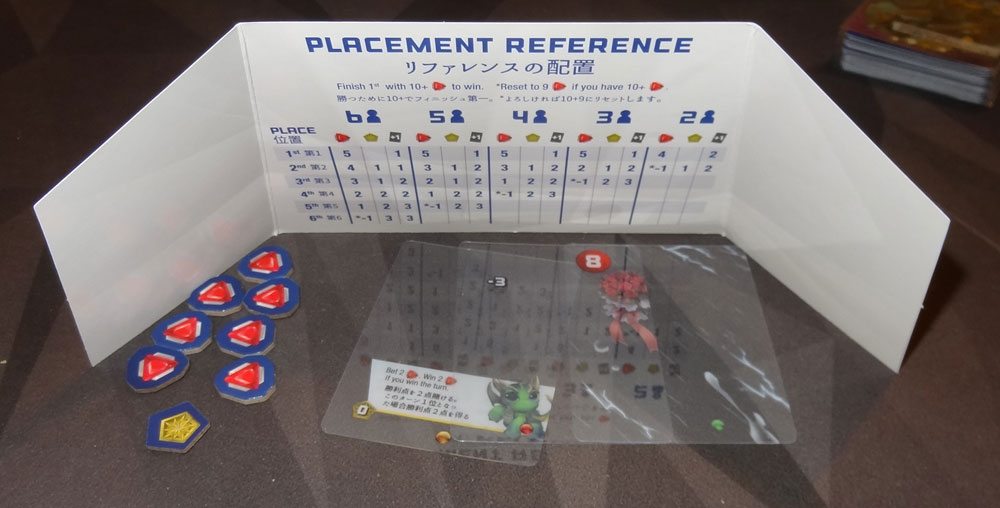
Scoring Phase: When you play the last card in your hand, you get to score based on your placing in that round. The first place will earn the most VP, and last place actually loses a VP. But players will also earn power tokens and card advancements. Generally, the worse you do, the more advancements and power tokens you’ll get.
Winning the Game
If you are first to run out of cards and you have 10 VP at the time you go out (before scoring), you win the game.
There are some rules for a Championship 7th Hand if nobody has won after 6 rounds, but otherwise that’s basically it.

Why You Should Play Custom Heroes
The core of Custom Heroes is the same as games like The Great Dalmuti—you have to play your cards in matching sets, and you’re trying to get rid of all of your cards first. But with the card advancements, you get to alter the values of the cards as you play. Need a pair of 5s? Let’s just add 2 to this 3. Or maybe I can subtract 3 from this 8. Or maybe I use Edge, the chameleon, to make another card wild, and play that with my 5.
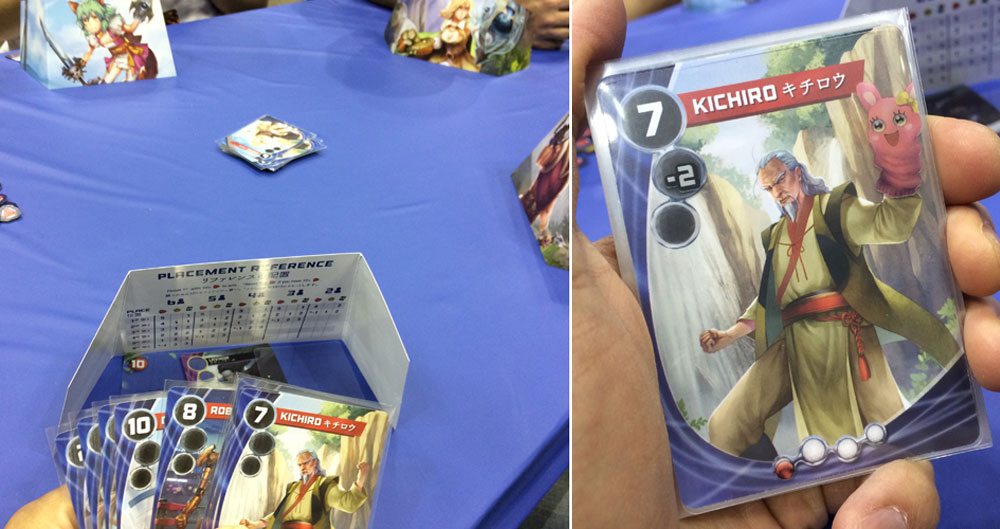
One thing I love about the advancements is the illustrations that go along with them. Advancements that add power to cards have things like weapons or a giant punching glove or a spell book. The really fun ones are those that subtract power—you get things like a sock puppet or a hot dog. There are a couple cards that just change the base value of the card entirely, and those tend to have some overlay graphics surrounding the character. The Ascended Form cards cover nearly the entire card, just allowing the base value and modifiers to show through—and it’s fun to drop one of these on a pile that somebody thought they were going to win.
The game itself feels pretty simple at the start: you’re just trying to maximize sets of cards so that you can get rid of everything. If you have pairs in your hand, then you want to try to win a trick so that you can lead with pairs. Sometimes there’s a question of how far to jump in value: do you play the lower value from your hand, hoping you can get rid of more cards, or do you jump to a higher value, hoping to shut other players out so that you can start the next trick?

Once you start throwing in advancements, though, that’s where things really start getting crazy. The game starts with one set of cards per player, so if you have five players, you know the best set that could be played is five 10s. But there is a power that lets you count a card as two copies of itself, and a power that lets a card have any value if played in a set. Add those to the cards that change values, and you might end up with somebody playing a set of six or seven cards, or bumping values up well beyond 10. (I think the highest I’ve seen so far is three 18s.)
Another wrinkle is the card that changes the order of the pile—now you’re going in decreasing order instead of increasing order. We had somebody play a pair of zeroes to win a stack once. As far as I can tell, there’s nothing preventing you from making negative numbers, either (though it hasn’t happened in my games yet).
One thing you always need to take into consideration when playing an advancement is that there’s no guarantee you will get the card back on your next round. So getting a pair of 12s might help you win this pile, but in the next round after the cards are shuffled and dealt back out, you may have just given somebody else a huge advantage. That’s particularly true of the Ascended Form—I used one of mine in the first round in one game, and then never got it back through the whole game, which meant other players were using my Ascended Form against me. You gotta know when to hold ’em and when to fold ’em, you might say.

I’ve only played The Great Dalmuti a couple times, and although I understand the various tactics for how to get rid of your cards, I was never really clear about the object of the game. You go out first, and you get to be a higher rank… and then you just play again. There’s no end to the game other than when everyone calls it quits, and I suppose maybe being the Great Dalmuti is kind of like winning? Custom Heroes gives you a more defined end-point, so that there’s a point to all that trick-taking and getting rid of your cards. I like the way that going out sooner gets you points, but going out later gets you more power tokens and advancements—it’s a nice balancing effect, so that players who did poorly will have more opportunities to modify their cards the next time around.
Custom Heroes adds some fun, wacky twists to the ladder-style trick-taking game. There’s a good deal of luck mixed in with the strategy—other than the Ascended Form and Kodora cards, you don’t always know what anyone else has, and because of the advancements, you can’t deduce what numbers are available by what’s been played, because the numbers can keep changing. I like how the game escalates: in most of the games I’ve played, it’s the lower numbers that tend to get upgraded first, so then by the end we’re mostly playing strings of high-value cards. There is a little bit of flavor in the rulebook about how we’re fighting off some enemies at the gates, but it’s mostly just a numbers game with fun illustrations, and the theme isn’t very important. It’s fun anyway.
If you like trick-taking games or just the idea of layering transparent cards to give a hero a blazing sword in one hand and a cabbage in the other, then you should definitely check out Custom Heroes. Look for it at your friendly neighborhood game store, or order a copy from Amazon!
Click here to see all our tabletop game reviews.
Disclosure: GeekDad received a copy of this game for review purposes.
